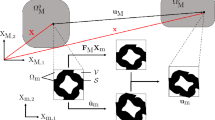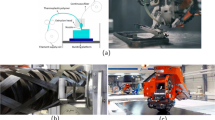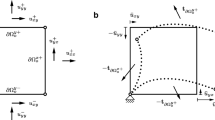Abstract
Polycrystalline materials can be characterized by the preferred orientation of grains within a material, otherwise known as texture. It has been shown that texture can affect a wide range of mechanical properties in metallic materials, including elastic moduli, yield stress, strain hardening, and fracture toughness. Recent advances in additive manufacturing of metallic materials allow for controlling the spatial variation of texture and thus provide a path forward for controlling material properties through additive manufacturing. This paper investigates the benefits, in terms of mechanical performance, of varying texture spatially. We examine the material properties of a hole in a plate under load and use an adjoint-based gradient optimization algorithm coupled with a finite element solver. The method of adjoints allows for efficient calculation of design problems in a large variable space, reducing overall computational cost. As a first step to general texture optimization, we consider the idealized case of a pure fiber texture where the homogenized properties are transversely isotropic. In this special case, the only spatially varying design variables are the angles that describe the orientation of the homogenized material at each point within the structure. Material angles for both a spatially homogeneous and a spatially heterogeneous material are optimized for quantities of interest, such as compliance and von Mises stress. Additionally, the combined effects of elasticity tensor and material orientation on optimized structures are explored, as the additive manufacturing processes can potentially vary both. This work paves a way forward to design metallic materials with tunable mechanical properties at the microstructure level and is readily adapted to other materials.
Similar content being viewed by others
References
Gibson, I., Rosen, D., Stucker, B.: Additive Manufacturing Technologies: Design for additive manufacturing. Springer, Boston, MA (2010)
Gibson, I., Rosen, D.W., Stucker, B.: Additive Manufacturing Technologies. Springer, Berlin (2010)
Goehrke, S.A.: Metal 3D Printing with Machine Learning: GE Tells Us About Smarter Additive Manufacturing. https://3dprint.com/191973/3d-printing-machine-learning-ge/ (2017)
Murr, L.E., Martinez, E., Amato, K.N., Gaytan, S.M., Hernandez, J., Ramirez, D.A., Shindo, P.W., Medina, F., Wicker, R.B.: Fabrication of metal and alloy components by additive manufacturing: examples of 3D materials science. J. Mater. Res. Technol. 1(1), 42–54 (2012)
Gorji, M.B., Tancogne-Dejean, T., Mohr, D.: Heterogeneous random medium plasticity and fracture model of additively-manufactured Ti–6Al–4V. Acta Materialia 148, 442–455 (2018)
Compton, B.G., Lewis, J.A.: 3D-printing of lightweight cellular composites. Adv. Mater. 26(34), 5930–5935 (2014)
Gu, G.X., Takaffoli, M., Buehler, M.J.: Hierarchically enhanced impact resistance of bioinspired composites. Adv. Mater. 29(28), 1700060 (2017)
Jared, B.H., Aguilo, M.A., Beghini, L.L., Boyce, B.L., Clark, B.W., Cook, A., Kaehr, B.J., Robbins, J.: Additive manufacturing: toward holistic design. Scr. Mater. 135, 141–147 (2017)
Zegard, T., Paulino, G.H.: Bridging topology optimization and additive manufacturing. Struct. Multidiscip. Optim. 53(1), 175–192 (2016)
Gu, G.X., Libonati, F., Wettermark, S., Buehler, M.J.: Printing nature: unraveling the role of nacre’s mineral bridges. J. Mech. Behav. Biomed. Mater. 76, 135–144 (2017)
Gu, G.X., Su, I., Sharma, S., Voros, J.L., Qin, Z., Buehler, M.J.: Three-dimensional-printing of bio-inspired composites. J. Biomech. Eng. 138(2), 021006 (2016)
Das, S., Bourell, D.L., Babu, S.: Metallic materials for 3D printing. MRS Bull. 41(10), 729–741 (2016)
Ding, Y., Muñiz-Lerma, J., Trask, M., Chou, S., Walker, A., Brochu, M.: Microstructure and mechanical property considerations in additive manufacturing of aluminum alloys. MRS Bull. 41(10), 745–751 (2016)
Raghavan, N., Dehoff, R., Pannala, S., Simunovic, S., Kirka, M., Turner, J., Carlson, N., Babu, S.S.: Numerical modeling of heat-transfer and the influence of process parameters on tailoring the grain morphology of IN718 in electron beam additive manufacturing. Acta Mater. 112, 303–314 (2016)
Makiewicz, K., Babu, S., Keller, M., Chaudhary, A.: Microstructure evolution during laser additive manufacturing of Ti6Al4V Alloys. In: Proceedings of International Conference on Trends in Welding Research, Chicago, IL (2012)
Dinda, G., Dasgupta, A., Mazumder, J.: Texture control during laser deposition of nickel-based superalloy. Scr. Mater. 67(5), 503–506 (2012)
Dehoff, R., Kirka, M., Sames, W., Bilheux, H., Tremsin, A., Lowe, L., Babu, S.: Site specific control of crystallographic grain orientation through electron beam additive manufacturing. Mater. Sci. Technol. 31(8), 931–938 (2015)
Brackett, D., Ashcroft, I., Hague, R.: Topology optimization for additive manufacturing. In: Proceedings of the Solid Freeform Fabrication Symposium, Austin, TX, USA, pp. 348–362 (2011)
Gaynor, A.T., Meisel, N.A., Williams, C.B., Guest, J.K.: Multiple-material topology optimization of compliant mechanisms created via PolyJet three-dimensional printing. J. Manuf. Sci. Eng. 136(6), 061015 (2014)
Gu, G.X., Chen, C.-T., Buehler, M.J.: De novo composite design based on machine learning algorithm. Extreme Mech. Lett. 18, 19–28 (2017)
Gu, G.X., Dimas, L., Qin, Z., Buehler, M.J.: Optimization of composite fracture properties: method, validation, and applications. J. Appl. Mech. 83(7), 071006 (2016)
Gu, G.X., Wettermark, S., Buehler, M.J.: Algorithm-driven design of fracture resistant composite materials realized through additive manufacturing. Addit. Manuf. 17, 47–54 (2017)
Soremekun, G., Gürdal, Z., Haftka, R., Watson, L.: Composite laminate design optimization by genetic algorithm with generalized elitist selection. Comput. Struct. 79(2), 131–143 (2001)
Bendsøe, M.P., Sigmund, O., Bendsøe, M.P., Sigmund, O.: Topology Optimization by Distribution of Isotropic Material. Springer, Berlin (2004)
Buhl, T., Pedersen, C.B., Sigmund, O.: Stiffness design of geometrically nonlinear structures using topology optimization. Struct. Multidiscip. Optim. 19(2), 93–104 (2000)
Eschenauer, H.A., Olhoff, N.: Topology optimization of continuum structures: a review. Appl. Mech. Rev. 54(4), 331–390 (2001)
Larsen, U.D., Signund, O., Bouwsta, S.: Design and fabrication of compliant micromechanisms and structures with negative Poisson’s ratio. J. Microelectromech. Syst. 6(2), 99–106 (1997)
Le Riche, R., Haftka, R.T.: Optimization of laminate stacking sequence for buckling load maximization by genetic algorithm. AIAA J. 31(5), 951–956 (1993)
Lin, C.-C., Lee, Y.-J.: Stacking sequence optimization of laminated composite structures using genetic algorithm with local improvement. Compos. Struct. 63(3), 339–345 (2004)
Multiphysics, C.O.M.S.O.L.: Modeling Software, User Manual (2016)
Brown, J.A., Bishop, J.E.: Quantifying the impact of material-model error on macroscale quantities-of-interest using multiscale a posteriori error-estimation techniques. MRS Adv. 1(40), 2789–2794 (2016)
Bower, A.F.: Constitutive models: relations between stress and strain, chap. 3. In: Applied Mechanics of Solids, pp. 91–93 (2009)
Svanberg, K.: The method of moving asymptotes—a new method for structural optimization. Int. J. Numer. Methods Eng. 24(2), 359–373 (1987)
Choi, K.K., Kim, N.-H.: Structural Sensitivity Analysis and Optimization 1: Linear Systems. Springer, New York (2006)
Acknowledgements
The authors would like to acknowledge Sandia National Labs for supporting this research. The authors would also like to thank Judy Brown, Joseph Bishop, and Eliot Fang for their immensely helpful discussions. Additionally, the authors would like to thank Sam Raymond and Maysam Bandpay for their insightful discussions. Authors also appreciate support from the NDSEG Fellowship.
Author information
Authors and Affiliations
Corresponding author
Additional information
Publisher's Note
Springer Nature remains neutral with regard to jurisdictional claims in published maps and institutional affiliations.
Rights and permissions
About this article
Cite this article
Gu, G.X., Buehler, M.J. Tunable mechanical properties through texture control of polycrystalline additively manufactured materials using adjoint-based gradient optimization. Acta Mech 229, 4033–4044 (2018). https://doi.org/10.1007/s00707-018-2208-1
Received:
Revised:
Published:
Issue Date:
DOI: https://doi.org/10.1007/s00707-018-2208-1




